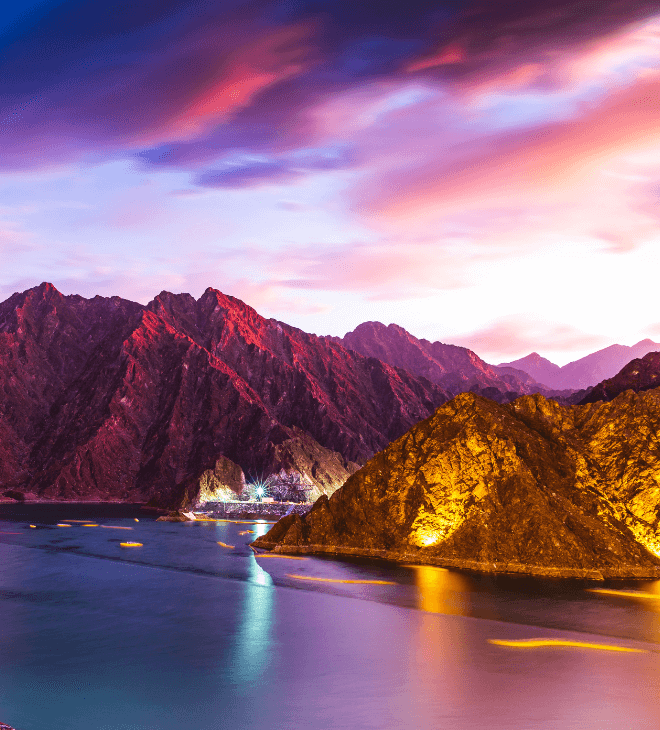Hatta: Pioneering sustainable tourism in the UAE

Renowned for its breathtaking mountain vistas and proud Arabian heritage dating back 3,000 years, Hatta is spearheading Dubai’s sustainable tourism push, providing a showcase for how contemporary development can seamlessly integrate with environmental conservation and the preservation of cultural traditions.
A key component of the ambitious Dubai 2040 Urban Master Plan, the Hatta Development Plan provides an exciting roadmap for Hatta’s transformation into one of the region’s top eco- and adventure-tourism destinations.
The Development Plan is structured around four key pillars: Wellbeing, Tourism, Sports & Activities, and Sustainability. These pillars guide the enhancement of community services, the development of innovative green transportation solutions, and the preservation of Hatta's rich cultural heritage.
By taking a holistic approach to transforming Hatta into a premier tourism hub, the plan’s implementation hinges on public-private partnerships that are driving crucial investments and creating job opportunities to bolster the local economy.
Celebrating Emirati heritage
Central to Hatta’s transformation is the celebration of Emirati heritage. The redeveloped Hatta Heritage Village and the newly constructed Hatta Souq provide visitors with a glimpse into the region’s history and traditions.
The Heritage Village features 30 traditional dwellings made from mountain stones, mud, and palm trunks, while the Hatta Souq, built using natural resources from the Hatta mountains, seamlessly blends with its surroundings.
The souq features cafes, restaurants, entertainment areas, and food carts, providing visitors with a vibrant and authentic Arabian marketplace experience. Additionally, efforts are underway to promote Hatta’s archaeological sites, such as the ancient Hatta tombs and Falaj Al Shari'a, with the goal of securing UNESCO World Heritage status.
Historical landmarks like the Hatta South Tower, Hatta North Tower, Mountain Fortress, and Al-Hara Fortress are being preserved and highlighted as part of the tourism campaign. The region’s ancient water channels, known as Aflaj, and its three historic mosques, including the 200-year-old Al Sharia Mosque, further enrich Hatta’s impressive cultural tapestry.
Promoting sustainable tourism
Dubai authorities plan to transform Hatta into a destination that not only promotes environmental conservation but provides economic opportunities for local communities. The Hatta Beach Project, for example, aims to transform the area into a year-round tourist destination. One of the planned highlights is the Crystal Lagoon, which will feature an artificial lake with a sandy beach and an array of leisure and water sport activities.
Another major attraction under development is the Hatta Waterfalls, located near the Hatta Dam. The site will feature a 5.4 km-long cable car connecting the base of the dam to the peak of Umm Al Nusour, Dubai’s highest peak, and a mountain tramway to enhance accessibility for visitors.
Additionally, new hiking trails and mountain bike paths are being developed for outdoor enthusiasts, allowing them to explore Hatta’s natural beauty. Hatta’s diverse terrain has long made it a popular destination with adventure seekers, who can often be found traversing the area’s existing hiking trails that span five key routes and a total area of 33km.
The Hatta Mountain Reserve is also set to prove hugely popular with adventure enthusiasts. Encompassing elevations from 250m to 1,060m, the reserve includes wadi ecosystems with significant archaeological and cultural value. It also showcases some of the world’s best-exposed Ophiolite formations, rare rock sequences uplifted from the ocean floor. Recognising its ecological importance, the reserve is listed as a tentative UNESCO World Heritage site.
Environmental sustainability is another cornerstone of the Hatta Master Development Plan. The planting of more than 13,000 native trees and the implementation of programmes supporting local farmers are integral to this effort, contributing to both the region’s ecological health and its economy.
To ensure that tourism benefits are widespread and community-based, the plan includes strong economic development programmes that support local entrepreneurs. These initiatives aim to encourage the development of innovative projects that stimulate economic growth and create new opportunities for the residents of Hatta.
A model for sustainable development
The Dubai government’s ambitious plans for Hatta aim to further enhance its appeal as a thriving ecotourism destination and a showcase of Emirati heritage. The Development Plan, deeply rooted in sustainability, is setting a new benchmark for how tourism and community development can coexist harmoniously.
With its strong focus on sustainable transportation and housing, Hatta is not just preserving its past but also building a future where tourism and community development go hand in hand, providing a working model for sustainable economic growth for the entire region.



